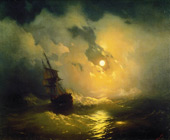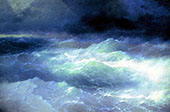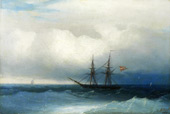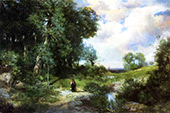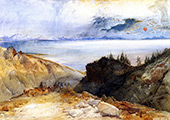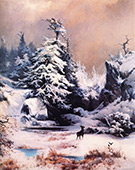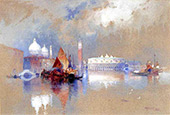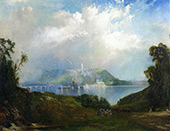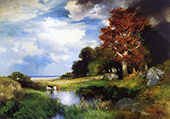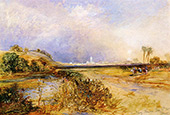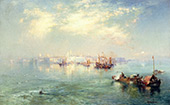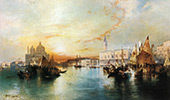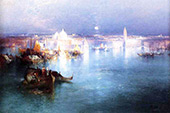Romanticism Oil Painting Reproductions
Find Romanticism oil painting replicas by Romanticism artists
Romanticism Paintings: A Brief Introduction
Romanticism paintings first appeared in Europe during the early 19th century. They define a movement in art and literature characterized by an interest in the human mind and individual emotions. Some of the most beautiful and enigmatic oil paintings of love are found in Romantic art. But who were the Romantic artists, and what inspired their work?
Explore Romanticism in art, from Caspar David Friedrich paintings to Delacroix's Liberty Leading the People.
Romanticism Art Movement
This art movement grew in Britain and France during the early 19th century and exploded in popularity mid-century. It remained influential until the late 1800s. It is not easy to define romantic art. Indeed, the French poet Charles Baudelaire said it couldn’t be explained “in choice of subject” or “in exact truth.” So instead, Baudelaire defined Romantic paintings as a “way of feeling.” Today, scholars define Romantic wall art according to its overarching ideas and approach. These famous oil paintings encompass individual imagination, subjective emotion, irrationality, and a return to nature.
What makes a Romanticism Painting?
Given the difficulties defining Romantic art, no specific characteristics make a painting “Romantic.” Nonetheless, oil paintings likely focus on emotions, feelings, and mystery. In addition, the subject matter varies widely, with Romantic artists depicting landscapes oil paintings, Seascape paintings, Religious Art, portrait paintings, and human tragedy.
The Romanticism art movement evolved due to several shifts in artistic and social attitudes. First, the dominant Classical art tradition, often pushed by institutions such as the French Academy and the Royal Academy in London, faded. From around 1780, an innovative approach emerged to emotion, spontaneity, and freedom. These ideas opposed the Enlightenment’s focus on rationality, logic, and industry. In place of Classical art restraints, Romantic paintings embraced solitude and meditation, devotion to beauty, and connections with the natural world.
Who were the leading Romantic Painters?
At the heart of the European industrial revolution, British artists embraced the Romanticism Art Movement. Painters such as John Constable and JMW Turner revolutionized depictions of nature.
European Romanticism Art
John Constable challenged traditional art hierarchy, elevating his humble countryside home to large, high-status art. JMW Turner emphasizes human helplessness and insignificance in the face of the power of nature in his famous landscape oil paintings. The atmospheric oil paintings like Valley of Aosta: Snowstorm, Avalanche, and Thunderstorm are held by the Art Institute Chicago. Comparably, visionary artist William Blake focused on man’s relationship with spirituality and the universe.
German artist Caspar David Friedrich paintings similarly focus on landscape scenes, driving the genre to new Romantic extremes. His artworks often included single figures set against huge, foreboding landscapes. Wanderer Above a Sea of Fog by Caspar David Friedrich is one of our most popular oil painting reproductions, and it is also included in our top 100 famous paintings.
French Romanticism Art
While French Romanticism art developed slowly due to the hold of Neoclassical approaches, it took off from the late 1810s onwards. Artists like Theodore Gericault and Eugene Delacroix brought Romantic practices into the present day. Indeed, both Gericault’s Raft of the Medusa and Delacroix’s Liberty Leading the People painting made strong social and political statements.
Art Historians also label Francisco Goya as one of the last great Romantic painters.
What are the five characteristics of Romanticism Paintings?
The five main characteristics of Romantic art include:
● Small, close brushstrokes combined with brilliant, complementary colors.
● Strong emotions and feelings as well as a celebration of individual imagination.
● An awe and appreciation of nature, alongside feelings of the “sublime.”
● Social themes such as revolution, republicanism, and democracy.
● An interest in psychology alongside the celebration of women and childhood innocence.
What is an example of Romanticism painting?
Here are five examples of Romanticism in art from the movement’s leading painters.
1. Caspar David Friedrich, Wanderer Above the Sea of Fog 1818
Among Caspar David Friedrich's paintings, Wanderer Above the Sea of Fog is one of the artist’s most iconic creations. The picture shows a young explorer standing confidently on a rocky outcrop. We view the man from behind as he gazes at a vast sea of fog. As such, this Romantic artwork focuses on inner emotions and the landscape.
2. John Constable, The Haywain 1821
The Hay Wain, by John Constable, is still one of the artist’s most famous oil paintings. Constable loved painting rural landscapes of scenes around his childhood home. In this oil painting, field workers return from a day’s toil. They are not separate from nature but form an integral part of the environment around them. As oversized wall art, The Haywain caused considerable controversy on its first unveiling in London. Nonetheless, the French art establishment adored John Constable’s paintings. King Charles X of France awarded Constable a Gold Medal at the Paris Salon for the work.
3. Eugene Delacroix, Liberty Leading the People 1830
Painted in 1830, Delacroix Liberty Leading The People is a true masterpiece of Romantic art. It epitomizes the French approach to Romanticism, combining skillful Realism and political sentiment. The painting commemorates the people’s July Revolution of 1830, which overthrew the French King Charles X. It references key Romantic themes of freedom, equality, and revolutionary fervor. With her breasts fully exposed, the central woman has similarities with classical Greek nudes. Yet, despite this, Delacroix represents her as a modern, individual female. Indeed, her fierce emotions and underarm hair show her as a “real” person rather than a classical ideal.
4. Joseph Mallord William Turner, The Fighting Temeraire 1838
Turner's The Fighting Temeraire is an iconic oil painting of British Romanticism. It represents a shi, the 98-gun HMS Temeraire, towed up the Thames by a small tugboat. As one of the last surviving vessels from the Battle of Trafalgar, the ship sailed toward a fate of scrap parts. The ghost-like beauty of the old warship contrasts with the blackened tugboat churning through the otherwise still river. Among JMW Turner's paintings, it is a uniquely emotional and poignant celebration of past bravery and bygone times.
5. John William Waterhouse, Mermaid 1900
Paintings by John William Waterhouse are particularly striking examples of Romanticism art. Associated with the Pre-Raphaelite movement, Waterhouse often worked with mythological and fantastical subjects. Mermaid by John William Waterhouse is a highly unusual artwork. Inspired by Alfred Lord Tennyson’s poem The Mermaid, it shows her as a beautiful yet dark enchantress. As tragic figures, Mermaids could not survive in the human world and were fated with a life of isolation and melancholy. On its first exhibition in 1901, The Art Journal praised Waterhouse’s depiction of the woman. The publication described her “wistful-sad look” with the “chill of the sea” lying forever on her heart.
Romantic Oil Paintings for Sale: High Quality Art Reproductions
Discover famous paintings of romantic art. This art movement encompasses some of the most beautiful and powerful oil paintings. If you enjoy the Pre Raphaelite art of John William Waterhouse or John Constable’s The Haywain oil painting, explore our collection of replica paintings. In addition, you’ll discover hand-crafted reproduction oil paintings to decorate your home or office walls.
Buy famous art reproductions depicting love and romance by some of your favorite artists.
Cannot Find What You Are Looking For?
Reproduction Gallery Information
Customer Service
(Send Us A Message)
Tel: (503) 937 2010
Fax: (503) 937 2011




